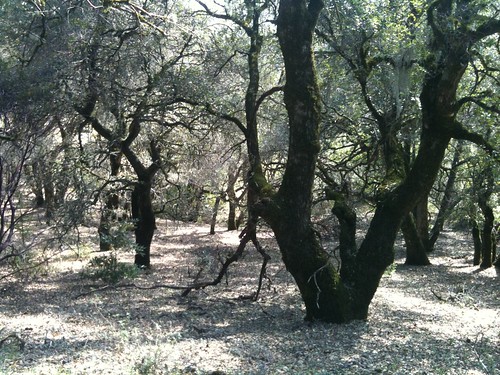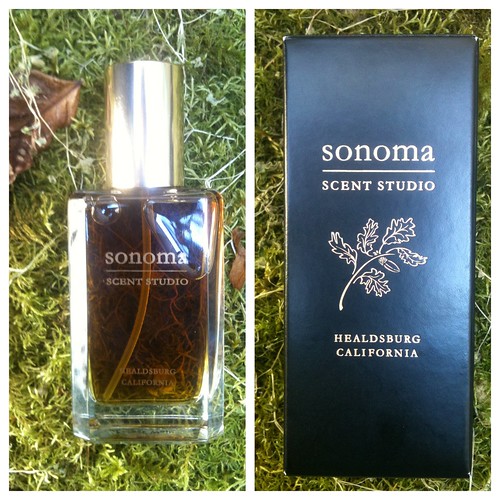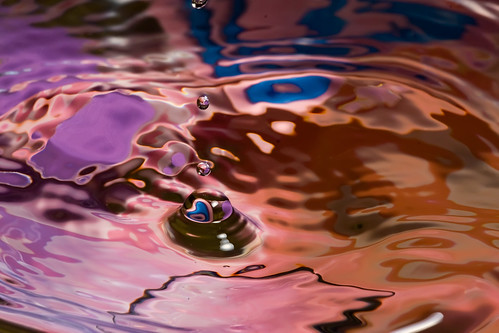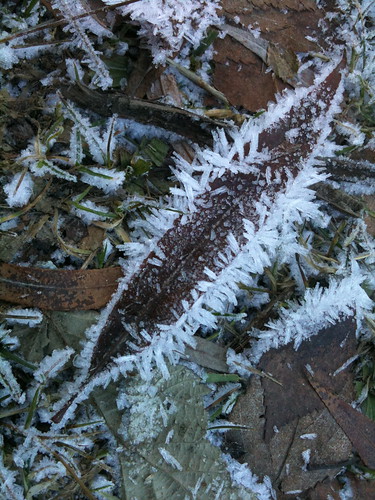
After a very eventful weekend, it was a special treat that Lisa has agreed to take a little road trip to Sonoma County to visit Laurie Erickson at her Sonoma Scent Studio. We were also hoping to sneak in a visit at Eden Botanicals, who recently moved to Petaluma (more about that in the next post).
The drive to Sonoma is scenic and picturesque. After crossing the bay's lengthy bridge, the hillsides in the summertime are all the colour of pale gold and look like a paint horse with big splashes of dark green oaks (the winter gives the exact opposite: dormant oaks, which are covered in parasitic moss, and green-grass-covered hills.
We ended up arriving to the county a bit to early, and it was lunch time, so thanks to my bad memory (Graton and Guerneville both start with a "G") we ended up in the wrong place after a very nice drive in the quite freeway along Russian River. And than, of course, we arrived a bit later than we hoped.
Climbing up Chalk Hill Road towards Laurie Erickson's Healdsburg studio, the country road is dappled with the generous shade of ancient oaks, and deer is not a rare sight (and they eat everything that Laurie and her parents try to grow - unless it's protected with a fence). Laurie's beautiful cottage is surrounded by a lovely garden with fragrant roses and violets, and is overlooking Chalk Hill Winery's vineyards, which were now completely covered in luscious green leaves (my first visit with her was in the spring, when they were still barren).

It was there in Laurie's own living room that I experienced
Forest Walk for the first time. It immediately struck a familiar chord, and it took me a few minutes to realize that it was just like the scent that emerges from certain spots in Stanley Park in late summer and early fall. The same warmth and sweet dryness of cedar and moss, plus a funky wet earth note that is reminiscent of the dark, musty scent of earth awakening from frost in spring time.
The funky wet-earth scent is very much owing to a synthetic molecule (whose name I failed to ask Laurie about, and is probably top secret) that you could easily recognize as the only thing in Demeter's "Dirt". It's also in Neil Morris' Dark Earth, but not nearly as much of it in Forest Walk - just enough to give it a realistic wet earth and a bit wild edge.
Forest Walk unfolds with many phases, always revealing a different aspect of the forest: a branch there, a leaf there, and oh - have you noticed this patch of wild violets over there? It's like a walk in a warm, needle-covered forest in summer (except, perhaps, for the violet patch), with oak trees and hanging moss adding a dry, tannin quality.
As the perfume develops on the skin further, the strange wet earth note dissipates, the Western red cedar softens and shifts to the background, and give way to deeper, earthier notes of many natural essences that I'm not only familiar with but also extremely fond of: labdanum and oakmoss with their brown, comforting warmth; black hemlock absolute (which I smelled at Laurie's studio for the first time - it's similar to pine needle absolute, less sweet and more dry-woody conifer absolute - where as fir (which is also present in this composition) takes on an extremely sweet, jam-like character. Other woodsy notes also add mystery and lasting power: New Caledonian sandalwood, aged Indian patchouli.
The labdanum intensifies over time on my skin, giving a rich ambery foundation to the rather rustic experience of hiking in the forest on a hot summer day and collecting needles in your hair and clothing after sitting down in a forest clearing to relax a bit, skin all salty and warm from the mild excursion.
The final dryout is woody yet smooth on my skin, with ambery-resinous notes amplifying (which is to be expected on my skin, it tends to make the sweeter notes grow), and only bare hints of sandalwood and patchouli. Interestingly, on Lisa's skin, the dry woodsy notes, including the red cedar, were far more apparent, and the "wet earth" facet lasted for far longer period of time. A living proof for the mysteries of differences between skin-chemistry.
When wearing it again for the 3rd time, and dousing it generously, an initial herbaceous note grabs my attention - is is sage, rosemary, or simply the herbaceous cineole from the needles? It might even be both. The jasmine sambac makes a glimpse of an appearance, though it's not exactly there as an identified note, but rather a clearing between the lush leafy tree tops that allows the light to shine through. And there is also the cool, clean, sweet yet tart note of vetiver in there that I haven't noticed before, and which adds a precious-woods aroma yet without ever touching a tree with an axe (
vetiver oil comes from the roots of a tropical grass related to lemongrass).
Like all of Laurie's creations, Forest Walk radiates warmth, depth, complexity and is very multilayered. It is about 50% or even more natural, which really gives it the aesthetic of turn of the century perfumes, which were only accentuated with synthetics for special effects (as opposed to cost-reduction, which is the main force behind most of what you smell nowadays). But it also stands out among all the collection of very fine perfumes for its unique storytelling, and also feels a lot less dense and floral than most.
Top notes: Wet Earth Notes, Western Red Cedar, RosemaryHeart notes: Violet, Orris, Jasmine Sambac, VetiverBase notes: Black Hemlock Absolute, Fir Absolute, Patchouli, Labdanum, Benzoin, Galbanum, Sandalwood (New Caledonia)Read other reviews of Forest Walk:
Mark's Review on Cafleurebon
Ida's Review on Fragrantica
Gaia's Review on The Non-BlondeAnd for those of you dying to try it, I'm giving away a sample of Forest Walk as part of the package that's going on to this week's
Monkey Monday winner. So don't forget to make a guess before tomorrow at noon about my smelly commute!







